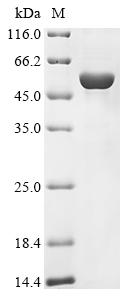The expression region of this recombinant Human ATP4A covers amino acids 350-783. This ATP4A protein is theoretically predicted to have a molecular weight of 54.6 kDa. This ATP4A protein is produced using e.coli expression system. The ATP4A coding gene included the N-terminal 10xHis tag and C-terminal Myc tag, which simplifies the detection and purification processes of the recombinant ATP4A protein in following stages of expression and purification.
The human potassium-transporting ATPase alpha chain 1 (ATP4A) is a subunit of the gastric H
+/K
+-ATPase, an enzyme crucial for the secretion of gastric acid into the stomach. ATP4A is primarily expressed in the parietal cells of the gastric mucosa and plays a key role in maintaining the acidic environment of the stomach, which is essential for digestion. ATP4A is involved in the active transport of protons (H
+) into the stomach lumen, where they combine with chloride ions to form hydrochloric acid. This process is critical for the proper breakdown of ingested food. Dysfunction in ATP4A can lead to gastric acid-related disorders, such as peptic ulcers or gastroesophageal reflux disease (GERD). Understanding its function is vital for developing therapeutic strategies targeting acid-related gastrointestinal conditions.




